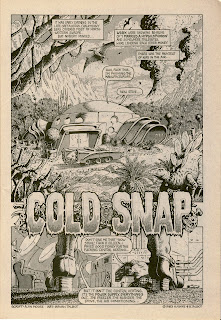1 / 5 Stars
‘Sargasso’ was published by Dell in 1977 (301 pp.); the cover artist is uncredited.
It’s the late 70s, and the crew of Apollo 19 are preparing to leave an orbiting Russian space station for splashdown in the Atlantic off the coast of Florida. But something goes very wrong, and the capsule is recovered - with what appears to be the burnt remains of three astronauts - contained within.
Captain Arthur Lovejoy’s deep-sea research vessel, the Lamprey, is near the splash site when suddenly all power aboard ship is mysteriously lost. Do the power failure and the loss of the Apollo crew have anything to do with their proximity to the Devil’s Triangle ? Or did the Lamprey have something to do with the calamity striking the Apollo capsule ?
The US government thinks so, and within a matter of days, Lovejoy finds himself out of his existing government contract, and his ship stuck in the dock for lack of operating funds.
But Lovejoy and his hard-charging scientific officer Paul Forsythe aren’t about to sit and take abuse from the feds. With some adroit political maneuvering, the team manages to convince a wealthy movie producer to sponsor a documentary trip by the Lamprey to the heart of the Triangle. There, they hope to solve the mystery of what appears to be a highway resting on the ocean floor.
But they’re not the only ones heading to the Triangle; a Russian trawler also wants a close look at the area, for reasons known only to the Soviet government. Add in a famous British sailor on a world-wide cruise, an elderly pilot who once encountered inexplicable events in the Triangle, an ambitious television reporter anxious for an inside story, and a trio of would-be treasure hunters, and the Sargasso Sea is going to be very crowded. But nobody is truly prepared for what the Triangle is about to throw at them…....
‘Sargasso’ is a pure beach read, made with an eye towards capturing the audience enthralled by the 70s best-sellers dealing with the Bermuda Triangle: Charles Berlitz’s ‘The Bermuda Triangle’ (1974), John Spencer’s ‘Limbo of the Lost’ (1969), and Richard Winer’s ‘The Devil’s Triangle’(1975).
Compared to other examples of 70s action / adventure fiction in the Clive Cussler / Alistair MacLean mode, ‘Sargasso’ doesn’t measure up well, and only the most hardcore fans of the genre will want to seek it out.
But Lovejoy and his hard-charging scientific officer Paul Forsythe aren’t about to sit and take abuse from the feds. With some adroit political maneuvering, the team manages to convince a wealthy movie producer to sponsor a documentary trip by the Lamprey to the heart of the Triangle. There, they hope to solve the mystery of what appears to be a highway resting on the ocean floor.
But they’re not the only ones heading to the Triangle; a Russian trawler also wants a close look at the area, for reasons known only to the Soviet government. Add in a famous British sailor on a world-wide cruise, an elderly pilot who once encountered inexplicable events in the Triangle, an ambitious television reporter anxious for an inside story, and a trio of would-be treasure hunters, and the Sargasso Sea is going to be very crowded. But nobody is truly prepared for what the Triangle is about to throw at them…....
‘Sargasso’ is a pure beach read, made with an eye towards capturing the audience enthralled by the 70s best-sellers dealing with the Bermuda Triangle: Charles Berlitz’s ‘The Bermuda Triangle’ (1974), John Spencer’s ‘Limbo of the Lost’ (1969), and Richard Winer’s ‘The Devil’s Triangle’(1975).
Unfortunately, author Corley starts more plot threads than he can devote adequate attention to, and the story never really gels into one coherent narrative. The main storyline tends to run out of gas at the end, and most readers will find the final revelations about the fate of the Apollo capsule to be underwhelming.
Compared to other examples of 70s action / adventure fiction in the Clive Cussler / Alistair MacLean mode, ‘Sargasso’ doesn’t measure up well, and only the most hardcore fans of the genre will want to seek it out.
























































